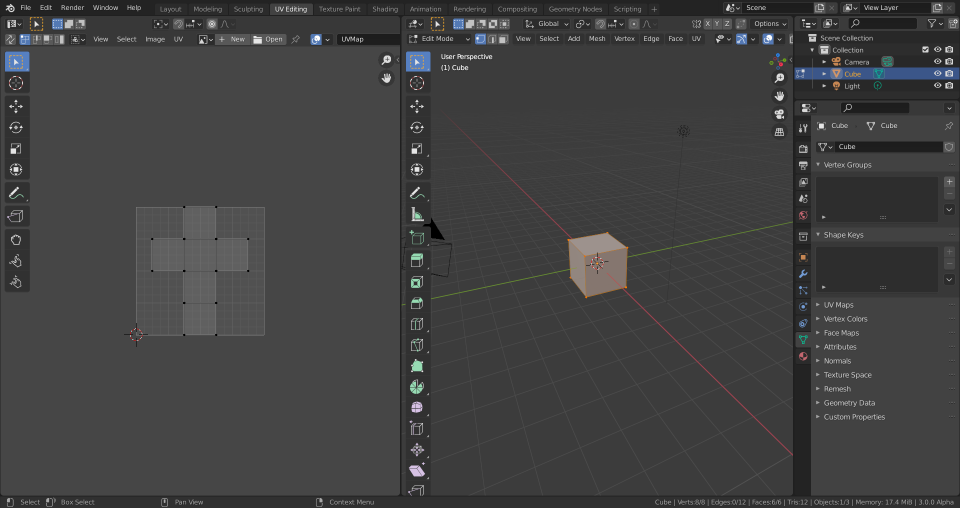Введение#
Первый шаг – развернуть меш. Обычно рекомендуется начинать развёртку, когда требуются лишь незначительные изменения геометрии модели. Если вы добавляете грани или подразделяете существующие грани, когда модель уже развёрнута, Blender добавит эти новые грани за вас, но вам может потребоваться выполнить дополнительное отображение или редактирование. Таким образом, вы можете использовать изображение UV-текстуры для руководства дополнительными изменениями геометрии.
О UV-развёртках#
Каждая точка на UV-карте соответствует вершине в меше. Линии, соединяющие UV, соответствуют рёбрам в меше. Каждая грань в UV-карте соответствует грани меша. Думайте о UV-карте как о проекции поверхности вашей 3D-модели на 2D-изображение.
Каждая грань меша может иметь множество UV-текстур. Каждой UV-текстуре может быть назначено индивидуальное изображение. Когда вы разворачиваете грань на UV-текстуру в UV-редакторе – каждой грани меша автоматически назначаются четыре UV-координаты: эти координаты определяют способ, которым изображение или текстура накладывается на грань. Чтобы отличать их от координат XYZ – для обозначения координат каждой точки используются оси U и V. Отсюда и название – UV-развёртка. Эти координаты можно использовать для рендеринга или для отображения вьюпорта в реальном времени.
В Blender’е, каждая грань может иметь ссылку на другое изображение. UV-координаты определяют, как это изображение отображается на грани. Затем это изображение может быть отрендерено или отображено в реальном времени. 3D-Вьюпорт должен быть в режиме «выделения граней», чтобы иметь возможность назначать изображения или изменять UV-координаты активного меш-объекта. Это позволяет задействовать одну грань во многих UV-текстурах. Грань на линии роста волос персонажа – может быть задействована и в UV-текстуре лица, и в UV-текстуре кожи головы/волос.
Более подробно это описано в следующих разделах.
Начало работы#

Стандартное рабочее пространство для редактирования UV.#
По умолчанию меши не создаются с готовыми UV. Сначала вы должны сопоставить грани, затем вы можете их редактировать. Процесс развёртки вашей модели выполняется в режиме редактирования в 3D-вьюпорте. Этот процесс создаёт один или несколько UV-островов в UV-редакторе.
Для начала выберите рабочее пространство UV Editing из списка для выбора в верхней части экрана в заголовке. Это рабочее пространство настроит одну из областей для отображения UV-редактора, а другую – для 3D-вьюпорта.
Войдите в режим редактирования, так как вся развёртка выполняется в режиме редактирования. Вы можете находиться в режиме выделения вершин, граней или рёбер.
Рабочий процесс#
Общий рабочий процесс выглядит следующим образом, но следует помнить, что для разных моделей могут потребоваться разные подходы к развертыванию:
При необходимости отметьте швы. Подробнее см. о «пометке швов».
Выделите грани меша в 3D-вьюпорте.
Выберите метод UV-развёртки из меню или из меню UV в 3D-вьюпорте.
Настройте параметры развёртки на панели настройки последней операции.
Добавьте тестовое изображение, чтобы увидеть, будут ли какие-либо искажения. Смотрите раздел о применении изображений к UV.
Настройте UV в редакторе UV. Смотрите раздел о редактировании UV.